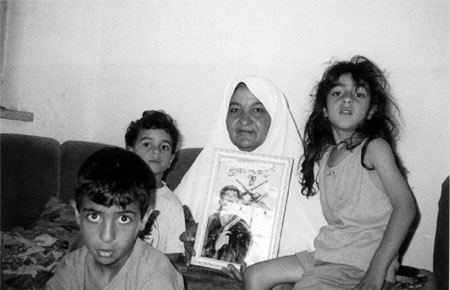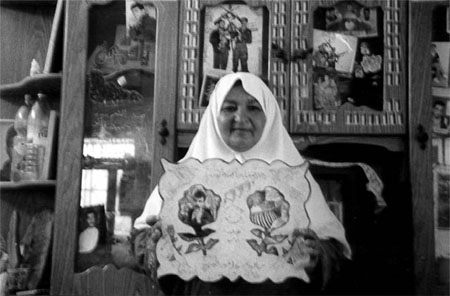
|
 |
|
Umm Yusif with picture of dead son and grandchildren. Am'iry Camp (Ramallah) July 1998 |
| Umm Yusif, Am'iry camp, Ramallah, July 1:
|
|
It's Ahmad Muhaisen who works with the PLO Directorate of Refugees who brings me here. He has work to do in the camp, drops me off with a pharmacist friend near the entry. I explain my project, and Samir takes me to a home on the outer edge of the camp. On the way he tells me that Am'iry people come mainly from the villages of Annaba, Salemi, al-Tireh, al-Na'imi (all near Ramleh and Lydd). He is taking me to meet the mother of a martyr whose house in Am'iry was dynamited in punishment during the first Intifada.
Umm Yusif agrees readily to record. She's alone with a large number of young children, one of whom is a son, the rest grandchildren. The house is dilapidated and dark. It's on loan, without rent, until they get an indemnity to rebuild their home in the camp. She says her husband is still alive, but blind and cannot work. She seems an old lady, but I calculate later cannot be more than 55 years old, since she was only an infant in 1948. This is the effect of refugee conditions, constant child-bearing, poverty. She tells her story with smiling composure, and lets me photograph her holding the photo of her martyred son, Abdel Moneim. The photos of another son who was deported and three who are in prison stand on the shelf behind her chair. One of the imprisoned sons was 14 years old when he was first arrested. The children around us are unusually quiet, perhaps over-awed by so many heroic absent uncles. Umm Yusif says it takes 600 shekels, and six hours coming and going to visit her imprisoned sons. One is in Ashkelon, one is in Nafah. She has not visited them for a long time. Though she begins with the hijra, Umm Yusif's narrative centers on her son, the martyr Abdel Moneim, who was sighted and shot by the Israelis as he entered Al-Aqsa to pray, after he had pretended to be a collaborator and then shot an Israeli mukhabarat captain.
Umm Yusif speaks: |
photos]. Then I gave birth to a fourth one, Nasser. And after Nasser I gave birth to Nasr. Those four, five, I had them in Gaza. After I had them, and there was the occupation, the situation in the Strip was bad, there was no source of work to live on. So my husband came here. My family had come here before, to Ramallah. They bought a house and lived here. They occupied us, the Jews..."
After I've finished recording Umm Yusif, and found my way back to Samir's pharmacy, Ahmad Muhaisen picks me up and takes me to the village of Silwad, north of Ramallah, where he has to act as official mediator in a row between refugees who have settled there and local villagers. This is an interesting experience, showing the situation of refugees in other locations than camps, and the uneasy relations between Palestinians who own their homes and land and those who have lost them. The refugees here are second time refugees who came from Gaza after it was occupied by Israel in 1967, and when Ariel Sharon began bulldozing wide streets through the Gaza camps to facilitate Israeli control. They were only 20 families at the beginning, now they are from 35 to 40. In the beginning relations between them and the people of Silwad were good -- "We married from them, they married from us". They had to pay rent for the land to the Israeli occupation; they were forbidden to build extra rooms. Since this is Area 'C', building without an Israeli permit is forbidden. Since Oslo, however, the refugees have begun to build. This has worried Silwad's people with the spectre of uncontrolled 'spreading'. No doubt it was to check this danger that Silwad Municipality decided to make a football pitch that will limit expansion of the unofficial 'camp'. In some places the edge of the pitch has cut into land already marked out for new refugee building. Fights between shabab over the boundary line have erupted. While Ahmad mediates, I sit in the shade of a vine with Abu Noman, originally from Lydd. One of his sons got hurt in yesterday's fight with Silwad young men, He says, "They call us settlers!" The refugee homes are small but there is green around them and small plots of land, unlike most camps. However there are disadvantages: the nearest UNRWA elementary school is four kilometers away; kids have to walk. After elementary, there's a government preparatory school; it's six kilometers away and not so good. Few girls ever get to do the end-of-school 'towjihi' exam. But one of the few who did is employed as a teacher in the kindgarden that the families got together to build. For health problems they have to go to the Am'iry camp clinic; to give birth, women go to Ramallah hospital. |
|
3. Abu Shusheh was the site of a massacre on May 15, 1948, that precipitated the flight of many surrounding villages. See www.palestineremembered.com |
 |
| Umm Yusif with picture of dead son. Am'iry Camp (Ramallah) July 1998 |
[Umm Muhammad al-Rashaydeh] [Hajii Zeinab Hashem Abdallah] Copyright©2005 |
|